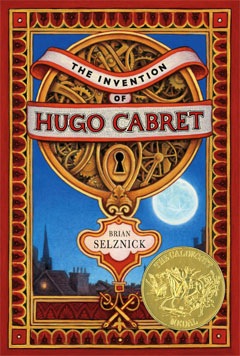The Newbery Award is the gold standard for children’s books; it’s awarded to one book each year (along with a handful of Honor books) and signifies the level of excellence that such past winners as A Wrinkle in Time, Sarah, Plain and Tall and The Graveyard Book imply.
But could a graphic novel win this award? Librarian Elizabeth Moreau says No, because the rules for the award call for it to be based on words alone, without the impact of illustrations:
“The committee is to make its decision primarily on the text. Other components of a book, such as illustrations, overall design of the book, etc., may be considered when they make the book less effective.”
That is fairly damning. You can’t consider illustrations unless they detract from the text. I imagine that is why The Invention of Hugo Cabret didn’t win its year.
Moreau goes on to read some YA graphic novels, and agrees that they don’t pass the test—not because the writing is subpar, but because the art is such an integral part of a great graphic novel.
Cartoonist/educator Chris Schweitzer shows up in the comments with an alternate view:
The Newbery is, and will likely continue to be, the most prestigious children’s literature award out there. I find it disheartening that great works of children’s literature might never be eligible because they employ a written language that is considered by many librarians to be illustration. Again, I contend that it is not. That this language is malleable and visually representational does not strip it of its function, which is to convey information as efficiently and elegantly as possible.
Not discussed: could a Graphic Novel win the Caldecott Award, which is presented for the best illustrations in a children’s book? Hugo Cabret won the Caldecott for Brian Selznick, and such comics-y types as Patrick McDonnell, Jon. J. Muth, and Lynd Ward have all been honor books. Here, I think the answer could well be, Yes.









butthurt fanboys are butthurt
I think this view will surely change as committee members become better educated about the value of the comics medium. It may seem to have taken a very long time to reach this moment in publishing but when you consider how relatively new the graphic novel format is, the recognition has been quite considerable.
There have been a lot of amazing works in the graphic novel/comics world that have set the table for today’s, and tomorrow’s artists that it’s only a matter of time before the Caldecott and other prestigious literary awards recognize the medium.
Here are the rules:
http://www.ala.org/alsc/awardsgrants/bookmedia/newberymedal/newberyterms/newberyterms
“Terms
1. The Medal shall be awarded annually to the author of the most distinguished contribution to American literature for children published by an American publisher in the United States in English during the preceding year. There are no limitations as to the character of the book considered except that it be original work. Honor books may be named. These shall be books that are also truly distinguished.
2. The Award is restricted to authors who are citizens or residents of the United States.
3. The committee in its deliberations is to consider only the books eligible for the award, as specified in the terms.”
“Criteria
2. Each book is to be considered as a contribution to American literature. The committee is to make its decision primarily on the text. Other components of a book, such as illustrations, overall design of the book, etc., may be considered when they make the book less effective.”
So there’s an exception right there. Does that mean if you remove the design or illustrations, and the book suffers, it can be reconsidered? Or that if a book relies on design or illustrations, it could be a detriment to the book?
The major benefit of excluding GNs from the competition, for the judges, is that the comparisons among books will be apples to apples. Note the emphasis on literary elements. Interpretation of a theme, development of a plot—comparing the effectiveness of those elements in a prose book to a GN would be difficult, especially when the book’s audience is children. They can’t be expected to react to artwork as an adult would.
If a child were given a choice between reading a prose book or watching a cartoon, he’d probably choose the cartoon, even if he’d watched it before, and even if it had no literary value, simply because the video is more fun to watch. When a child reads a prose book, he’s processing the information in the text, even if he eventually finds it boring.
SRS
It would be a pretty uphill battle for a graphic novel to win the Newbery for several reasons: discomfort with the comics’ form, resistance to change, etc, but the most important reason is that, generally speaking, the book selected for the Newbery is a book appealing to adult sensibilities as opposed to children’s. For example, why hasn’t Mike Lupica won the Newbery? Kids adore his books while adults don’t. The selection of Gaiman’s Graveyard Book was an exception. For a graphic novel to win the Newbery it would have to be released under a children’s imprint while appealing to adults.
Or somebody could create a literary award for children graphic novels. Do a good job of it and it too may become prestigious like the Newbery.
They should start a Newcott-Caldeberry Award for YA graphic novels.
Interesting – no doubt, when the right graphic novel comes along, it will have as fair a chance at the award as any other publication. I think as graphic novels continue to gain attention (from both youth and adults) the possibilities only increase.
Great post, keep up the great work. I put a link up on my blog: http://zombie-dinosaurs.blogspot.ca/2012/08/lindelof-loves-underwater-welder.html
Rob,
It’s called the “Printz Award”. It’s the Newbery for young adult literature.
“American Born Chinese” won the award a few years ago. (It was a finalist for the YA National Book Award.)
Benny and Penny in the Big No-No! by Geoffrey Hayes won the Geisel Award for best beginning reader book.
Matt Phelan’s The Storm in the Barn won the Scott O’Dell Award for Historical Fiction.
If you look at it the right way, David Macaulay’s “Black and White” is an experimental graphic novel. It won the Caldecott in 1991. Or you can consider “In The Night Kitchen”, winner in 1971, as an earlier GN.
—
It counts as a footnote, but a graphic novel has been included in the Noble Prize in Literature, which recognizes an author’s work, not a particular novel. Doris Lessing (2007) wrote “Playing the Game” in 1995, illustrated by… Charlie Adlard?! She has also written libretti for two operas (one with Philip Glass), and three collections of cat tales.
@Steve — If there’s one group of award judges who represent the opposite of what you describe, I would say it’s the ALSC division of the American Library Association, who are in charge of the Newbery. Outside of the Direct Market, there’s no greater advocate for comics and the value of comics for building literacy than the ALSC.
Liz’s article was really interesting in that it brought to light something that really should have been vigorously debated before — this rule that was clearly meant to prevent judges from considering non-story aspects of a book, not to eliminate an entire category of book from consideration. I don’t think she’s saying that the Newbery is resistant to change or somehow anti-comics at all.